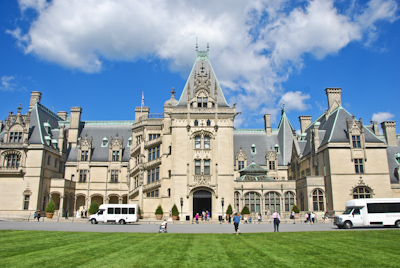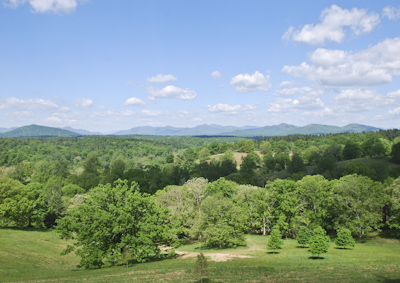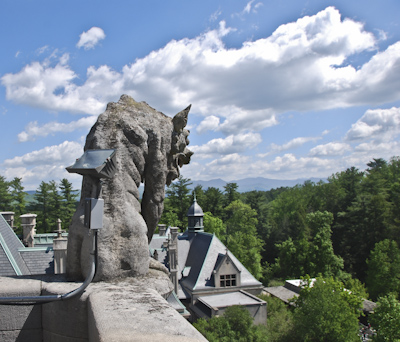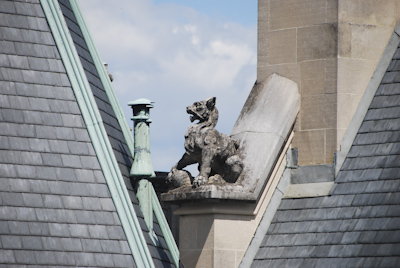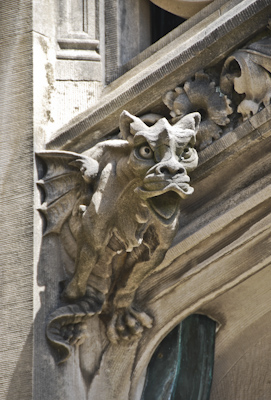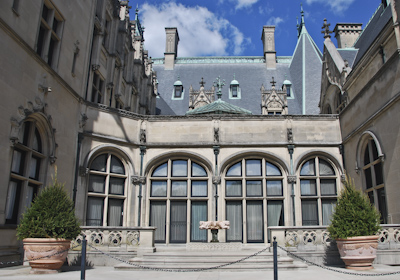Friday – April 29, 2011
Two important events occurred today: Prince William married Kate Middleton in London, England and we visited The Biltmore Estate in the city of Asheville, North Carolina. It might have been raining in London, but in Asheville the weather was perfect! It was a bright sunny day with a brilliant cloudless-blue sky. The temperature in the morning was 55 degrees. The mountain air was crisp and clear.
The Biltmore House is the largest home in the United States with 250 rooms. It was built between 1889 and 1895 by George Washington Vanderbilt and modelled after several French Chateaus in the Loire Valley. He was the youngest son of William Henry Vanderbilt and the grandson of Cornelius Vanderbilt, who had generated great wealth by building railroads and shipping companies.
As the story goes, George traveled to Asheville with his mother in the 1880s and fell in love with the beautiful mountainous region. Asheville was renowned during Victorian times for its health spas and Mrs. Vanderbilt, who was elderly, wanted to “take the waters” for her arthritis.
George bought thousands of acres of land very cheaply and hired Richard Morris Hunt to design the house and Frederick Law Olmsted to create the landscape and gardens. The house is still privately owned and operated as a business by George’s descendents. The estate today covers 8,000 acres and has become an international tourist destination. Daily tickets to the house and grounds cost $54.00 each for adults. We had bought our tickets at the hotel the day before and they were good for two-days admission to the estate.
 View of the Estates from the Balcony
View of the Estates from the Balcony
We arrived at the Biltmore Estate by 10:00 o’clock and drove through the beautiful landscaped grounds for many miles. We followed a long string of cars before we were directed to Parking Lot C and then walked to the small station to wait for the shuttle from the parking lot to the house. The bus filled up quickly and we rode for more scenic miles to the mansion. The driver told the riders about the history of the house and family and then explained the general rules of the Biltmore.
The first view of the house is very impressive! The mansion is huge and really looks like one of the French castles along the French Loire Valley. The shuttle bus left us off right in front of the main entrance to the house. Jeff saw a sign somewhere with a list of guided tours and, because we’re both interested in architecture, he thought it would be fun to take the Architect’s Tour. We bought additional tickets at $17.00 each and, after taking a few exterior photos, walked up the stairs and into the magnificent entrance of the house.
Fresh flowers in huge vases greet visitors in the vestibule. At the top of the interior stairs is the large inner hall. The first room that the visitor sees to the right is the Winter Garden. It is a three-story glass and wood domed atrium filled with beautiful tropical plants and trees. Lovely iron Art-Deco lanterns hang down from the ceiling. The light was exquisite. Our camera shutter-fingers were itching, but there was NO photography in the house.
The “Architects Tour” started at 11:00 and was conducted by one of Biltmore’s professional guides, Garrett LaBoda. After he gave everyone a tag, we followed him out to the front of the building where Garrett talked about the design of the exterior. He told us the history and showed us the hidden acorns and leaves in the masonry.
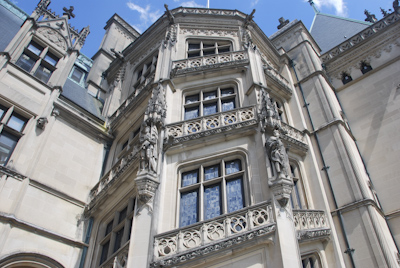 Exterior of the Main Staircase
Exterior of the Main Staircase
Next we entered a side door and Garrett led the small group of about a dozen people up the magnificent main marble staircase to the fifth floor. A family elevator had been installed near the stairs, but this is only used by handicapped people today. We climbed up to a section near the roof of the house which is not open to the general public. There was a huge model of the house in the middle of the room and prints of the French Chateaus and English Castles on the walls. The next room was George Vanderbilt’s office and later his wife’s art studio which was at the top of the front tower of the house. We were also able to see a small narrow attic space which gave us a glimpse at the construction of the building. Unlike the medieval French Chateaus which were built of stone blocks, Biltmore was constructed of iron and bricks with a facade of cement to look like stone blocks.
A small door led out to a narrow balcony which encircled the top of the tower room. We all walked out on it and looked around. We were able to take photographs here. There were a couple of charming gargoyles which decorated the corners of the balcony.
We followed Garrett across the studio to the roof of a dome which supported the magnificent five-story iron chandelier which hung down through the main staircase. We enjoyed another wonderful bird’s eye view of the grounds and gardens. We also went out onto a large porch toward the back of the house. In each of these locations, Garrett pointed out architectural details of interest and told many interesting stories about the Vanderbilts. It was an engaging tour and the hour passed quickly.
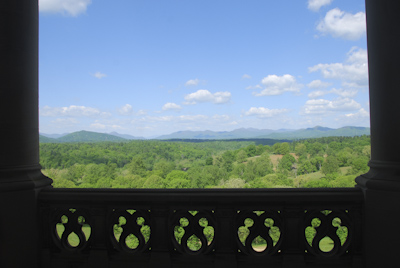 View of the Mountains From a Balcony
View of the Mountains From a Balcony
Afterwards, we walked to the former stables of the estate which had been converted to restaurants and gift shops. We sat for a while and enjoyed Southern sweet tea before continuing our self-guided tour of the mansion. We have found that it helps to take sitting breaks when we’re sight-seeing so we don’t get burned out before the end of the day. I guess that’s one of the disadvantages to our age.
With the official Biltmore self-guided tour pamphlet in hand, we began our tour of the house. Unfortunately, photography is strictly forbidden so I have no photos of the interior. Over many years, we have seen many large mansions which belonged to wealthy robber-barrons of American history, including Newport’s “summer cottages” and William Randolph Hearst’s house in California. A couple of weeks ago we visited Flagler’s mansion in Palm Beach Florida. Biltmore ranks high on this list of impressive “homes” with huge marble ballrooms and dining rooms decorated with Flemish tapestries and exotic wood and marble. It was noted that George Washington Vanderbilt’s library contained 23,000 books and had Napoleon’s chess set on display. The cozy family bedroom suites were decorated in antiques and rich fabrics. There was heavy red brocade in George’s bedroom with hidden closets. Edith’s bedroom was decorated in an eye-opening bright yellow and purple satin, which were supposed to be her favorite colors.
Probably the most interesting were the “downstairs” rooms. This is where the servants lived and worked to support the “upstairs” owners. We saw bedrooms, kitchens, pantries, storage rooms, laundry rooms, and rooms to store dishes and silverware. Downstairs was also the location of an exercise room, changing rooms for guests, and the indoor heated swimming pool. Many rooms in the house were on display and visitors followed a path through the open rooms. The self-guided pamphlet gave adequate explanations of the highlights of what we were seeing.
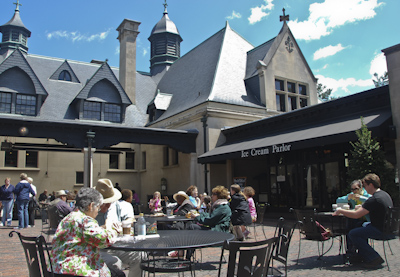 Former Stables of the Biltmore Estates
Former Stables of the Biltmore Estates
Afterwards, we left the house and debated how tired we were and whether we wanted to see the grounds today or save it for tomorrow. We took the shuttle back to the car and drove to Antler Village on the estate grounds. This was a small grouping of buildings which included restrooms, a pub & restaurant, winery with tours, dairy for ice cream, and The Legacy Building. The Inn at Biltmore looks down on the village and shuttle buses transport Inn guests anywhere on the estate. There is a fountain and a gazebo in the center of the village where a couple of young people were playing music. We walked around the village and stopped at the dairy to sit and have an ice cream break.
Our architectural tour guide had enthusiastically recommended a stop at the Legacy Building. When we entered, the woman at the door said that a “talk” had just begun in the auditorium. The professional tour guides gave free talks about the Vanderbilts, Biltmore history, and their experiences working there and answered visitor’s questions. The woman giving the talk was very enthusiastic about Biltmore. She talked about the history and told anecdotes of the family and the Saint Bernard dog, Cedric. We learned that Antler Village was built less that a year ago. Outside the auditorium, there was a display of Vanderbilt family possessions and photos of the current descendants who own and operate the Biltmore Estates.
A sister of the CEO manufactures and sells reproductions from the house. We definitely had the feeling that the entire estate is one very large business enterprise. It was amazing that the people of the city of Asheville also support and buy into the positive caring message of the current owners. Perhaps the quantity of tourists who come to Asheville to see Biltmore help the economy of the city. Also, yearly passes cost about $100. which gives people unlimited access to the estate. Besides the house, the hotel, and Antler Village, there are hiking trails, horse stables, picnic tables, and 8,000 acres of beautiful land to explore for local residents.
We had spent the entire day at Biltmore. We were getting tired, so at about 4:30 we drove back to our hotel to rest before dinner. In the early evening we drove into downtown Asheville. The city is in the process of celebrating its Art Deco architectural history by restoring many of the buildings in the downtown. It was Friday night and we had a bit of difficulty finding parking. As we got out of the car, we could hear drumming.
There is a small triangular-shaped park, called Pritchard Park at the intersection of College Street and Patton Avenue and it was full of people. A large group of men and women were drumming in unison and others were dancing barefoot in the center. Some people were twirling hoola-hoops and a few were kicking around a hacky-sack. It was a flash-back to the ’60s! It was easy to move to the loud drumming. We learned later that this was the Friday evening drum circle, a weekly event.
Our goal was a popular restaurant called Tupelo Honey Cafe across the street from the park. Michael, the desk clerk at the hotel, had recommended Tupelo because it serves fresh seasonal food and gets much of its produce and meat from local farms. We had to wait 40 minutes for a table because there were so many people. We waited outside and watched the parade of interesting passersby and listened to the drum beats. When we finally got a table, the menu was wonderful with lots of fresh veggie dishes and innovative combinations. I ordered “three sides” of mashed root vegetables, fried tofu, and benne Brussels sprouts. They were delicious!!
It was dark when we finished dinner. It was a pleasant crisp clear evening. The drumming was louder and the dancing area was packed with gyrating bodies. We walked back to the car. Asheville is a “happening place”! We didn’t see much of it so we have a good excuse to return someday. We missed the River Arts District near the FrenchBroad River, where artists’ studios and performance spaces are housed in old warehouses. We didn’t visit the Victorian home of the American author, Thomas Wolfe. We did see the Main Street area of innovative shops selling everything from clothes to housewares to handmade crafts. There is much to see and do in Asheville and I will return, someday soon.
